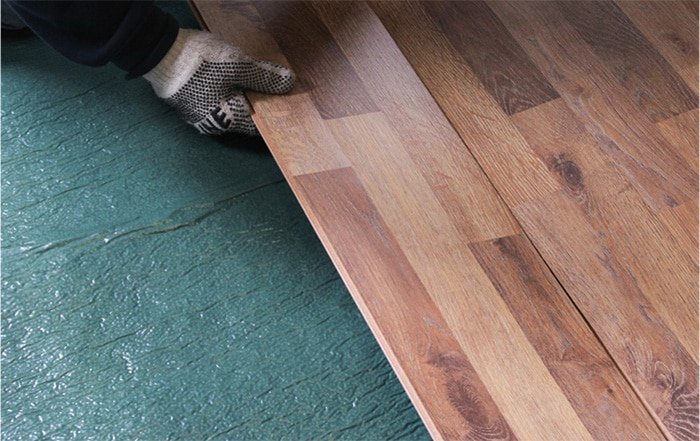Choosing the thickness of vinyl flooring, be it tile or plank, is crucial. Because of the wooden look you are trying to achieve, it is highly suggested by us here at Europine that you consider the size of each plank for your specific project, by selecting the thickness of the layers, particularly the vinyl core and the top wear layer. Another vital consideration is the choice of installation method. The methodology of installing your floor will not only affect the duration of your operational downtime, but it can also go a long way in determining the long term integrity and overall feel of your vinyl flooring.
Calculating Layer Size
There are three layers to consider when trying to calculate the plank thickness, also referred to as plank size or depth. The top wear layer, the vinyl core, and finally the backing. These three layers are the ones typically manipulated to achieve the different specifications that can suit any industry.
Thickness for Low Traffic Areas:
2-3 mm (0.079-0.118 in)
For areas that experience low amounts of foot traffic, you may opt for planks that are thinner and smaller. The most commercially widespread thicknesses for these types of floors are 2 mm (0.079 in), 2.5 mm (0.098 in), or 3 mm (0.12 in).
- One positive aspect is that opting for smaller plank sizes almost always results in lower costs, making it a breeze on your budget.
- On the other hand, thicker vinyl planks can mask any subfloor imperfections. This means it is imperative to have evenly installed the concrete floor beneath the planks. Any mistakes in the laying of the concrete subfloor will be more likely to show through on thinner planks.
Thickness for High Traffic Areas
3.2-4.0 mm (0.13-0.16 in)
The industry standard minimum thickness for floors that are in areas considered “high foot traffic” is 3.2mm (0.13 in). Some clients require vinyl planks as thick as 4mm (0.16 in) to ensure the floors can withstand brutal and frequent poundings. This range of thickness strikes a happy medium between long term integrity/durability and affordable pricing. At this category of plank size, the floors begin to acquire that “soft underfoot” feel that provides comfort as you walk.
Thickness for Optimized Quality
5.0-8.0 mm (0.20-0.31 in)
4mm planks provide reliable support and endure quite a while, but the best vinyl floors that manufacturers produce can range from 5mm of thickness up to 8mm. These planks are more expensive, but with good reason; the thickest planks not only last the longest and feel the most comfortable, they imitate wood the most faithfully.
Another benefit of thicker planks is that you don’t have to worry as much about the subfloor. Whether you have imperfections in a concrete or hardwood subfloor, the densest vinyl floors will naturally even out any flaws from the subfloor installation process.

The Protective Wear Layer
Between the UV coating finish and the print/design layer, there is a layer responsible for the majority of the protection for your luxury vinyl planks. Known as the wear layer, it is the single most significant determinant of how the integrity of your flooring progresses over time.
The design layer, where the aesthetic magic happens, is shielded from damage of all sorts by the wear layer. Without this armor, the printed design can be damaged, ultimately ruining the plank itself. Here at Europine we suggest investing in specialized, protective coat finishes to bolster the wear layer and the anti-UV coating. Most of these coatings are fortified by adding substances that harden the plank further, such as ceramic derivatives.
**NOTE: The wear layer is measured with a unit called mil. This unit is NOT a millimeter (mm). To illustrate, 40 mil = approx. 1.0 mm (millimeter).
The higher the wear layer thickness is, the more the plank can resist surface damages, like scratches, scuffs, and dents. With specialized coatings, these planks can become nearly immune to visible scars. Of course, since the thickest floors are the best quality vinyl plank flooring on the market, they are also the most expensive. What we have found here at Europine is that the average commercial or industrial operation opts for 28 mil wear layers. The smaller wear layers tend to be more appropriate for residential purposes, while thicknesses above 28 mil tend to be for floors that expect constant, heavy loads and high traffic.
Cores Layers and Backings
Rigid Core flooring planks possess extended durability and increased stability. These solid cores also resist water and moisture, as well as hiding whatever flaws or imperfections exist in the subflooring (typically from improper installation execution). This means that SPC flooring is the better option when being installed over a pre-existing floor.
Have a particular question for us?
If you ever find yourself needing/wanting to discuss any of these topics, or even just to ask your questions, please feel free to contact us. In fact, Europine encourages and welcome any and all further inquiries regarding your flooring concerns.
